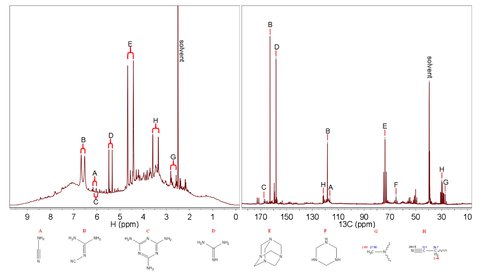2012 Annual Science Report
 NASA Jet Propulsion Laboratory - Titan
Reporting | SEP 2011 – AUG 2012
NASA Jet Propulsion Laboratory - Titan
Reporting | SEP 2011 – AUG 2012
Task 3.4.1 Tholin Chemical Analysis Using Nuclear Magnetic Resonance
Project Summary
One effort is to develop techniques for analyzing the structural features of Titan organic aerosol analogues (tholins) and HCN polymers.
Project Progress
Co-Investigator Mark Smith and Graduate Student Chao He are employing multinuclear and multidimensional nuclear magnetic resonance (NMR) spectroscopy to investigate the structure of these polymeric materials with 13C and 15N isotopic enrichment. HCN polymers, resulting from the polymerization of hydrogen cyanide molecules, are considered to have profound implications for prebiotic chemistry, and contribute to the carbonaceous components in many bodies of the solar system. Titan tholins, the Titan haze analogs, are produced in the laboratory to understand Titan’s organic chemistry and the prebiotic potentials. Both materials are complex organic compounds, and HCN polymers are proposed to be constituents of tholins. Their definitive organic structure and composition still remain unclear.
The 13C and 15N labeled HCN polymers are prepared under anhydrous condition from H13C15N, and then dissolved in DMSO-d6. The solution-state NMR experiments are carried out on Bruker DRX 500, Bruker DRX 600, and Varian INOVA 600: first, the 1H, 13C and 15N 1D experiments with different decoupling; then, the 2D/3D correlation experiments. Upon analyzing these NMR spectra carefully, some discrete structural units for the most concentrated small molecular components were identified, and the polyimine chain-like structures are suggested for the polymers. In the presence of a base such as ammonia or triethylamine, HCN molecules mainly polymerize to the polyimine chain-like structures by forming new carbon-carbon bonds.
(95:5) mixture, and dissolved in DMSO-d6. The multinuclear and multidimensional NMR experiments were also carried out. The 1-dimensional 1H, 13C and 15N NMR spectra and decoupling experiments indicated the small molecule functional inventory and polymer chemical environment and suggested that the tholin sample contains amine, nitrile, imine and N-heteroaromatics. Combining NMR and mass spectrometry, hexamethylenetetramine (HMT) was identified as the major small molecule component in the Titan tholin, which is confirmed by authentic sample. Its precursor (1,3,5-hexahydrotriazine) is also detected, suggesting that HMT is formed via polymerization of methanimine (CH2=NH). From the analyzed NMR results, more small molecules were identified, such as cyanamide, guanidine, 2-cyanoguanidine, and melamine, suggesting another set of chemical pathways for nitrogenous species in the tholin.The NMR results show that the chemical composition of tholins is more complex than HCN polymers, and HCN polymers appear as minor components of Titan tholins. The structural investigation of polymers in tholin is still ongoing.
Figure 1. The 1H and 13C NMR spectra of 13C and 15N labeled Titan tholin, the identified small molecules are listed at the bottom.
Publications
-
He, C., Lin, G., Upton, K. T., Imanaka, H., & Smith, M. A. (2012). Structural Investigation of HCN Polymer Isotopomers by Solution-State Multidimensional NMR. The Journal of Physical Chemistry A, 116(19), 4751–4759. doi:10.1021/jp301604f
-
He, C., Lin, G., Upton, K. T., Imanaka, H., & Smith, M. A. (2012). Structural Investigation of Titan Tholins by Solution-State 1 H, 13 C, and 15 N NMR: One-Dimensional and Decoupling Experiments. The Journal of Physical Chemistry A, 116(19), 4760–4767. doi:10.1021/jp3016062
-
PROJECT INVESTIGATORS:
-
PROJECT MEMBERS:
Chao He
Doctoral Student
-
RELATED OBJECTIVES:
Objective 2.2
Outer Solar System exploration
Objective 3.1
Sources of prebiotic materials and catalysts
